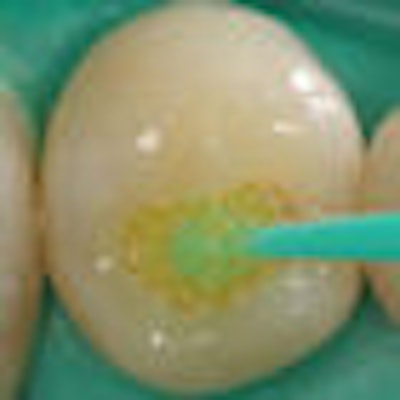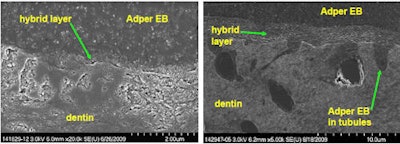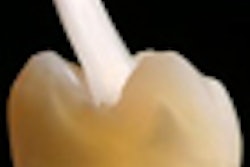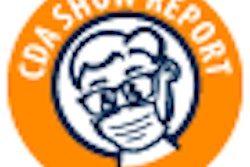
Can one adhesive work in both etch-and-rinse and self-etch systems? Researchers showed data supporting that notion at the recent American Association for Dental Research (AADR) meeting in Washington, DC.
"Many dentists use both a total-etch and a self-etch system in their offices for different cases," said Richard Rusin, Ph.D., a senior product development specialist at 3M ESPE, in an AADR presentation. "But it can be costly, confusing, and, frankly, cause a lot of office clutter to have the two adhesives in the operatory. For that reason we began to realize it might be desirable for a dentist to be able to use one adhesive in both modes."
Rusin presented data that indicated 3M's Adper Easy Bond could work as just such a "switch hitter." While 3M doesn't currently recommend it for that purpose, Rusin's laboratory studies suggest that it could bond well to etched dentin.
In fact, this month 3M will begin distributing brochures that say Adper Easy Bond is particularly well adapted to a "selective enamel etching" technique in which dentists apply phosphoric acid to both cut and uncut enamel while avoiding dentin: the so-called "selective enamel etching" technique.
Multiple generations
Many studies have shown that as dental adhesive systems have gotten easier to use, they've lost strength (for example, the Journal of the American Dental Association, April 2007, Vol. 138: 4, pp. 507-514). Fourth-generation systems -- in which primer, etchant, and adhesive were in three different bottles -- are usually stronger than fifth-generation systems, in which the primer and adhesive are combined. (Both fourth- and fifth-generation systems are known as "total-etch" or "etch-and-rinse.")
Sixth-generation systems, in which the etchant and primer are combined, have generally proved weaker than fifth-generation systems. And seventh-generation systems have so far appeared to be the weakest yet. (Sixth- and seventh-generation systems are collectively known as "self-etch" adhesives.)
That finding was reinforced in another AADR presentation. University of Alabama at Birmingham researchers found that 3M's fifth-generation product, Single Bond Plus, had greater shear bond strength than Easy Bond or the company's sixth-generation Scotch Bond SE after 11 months of storage in water. (However, in a six-month clinical trial, another group from the same institution found no difference among the three adhesives.)
So why use self-etch? In addition to the convenience of eliminating steps, some clinicians have found the self-etch systems cause less sensitivity. That's because the acids within them are not as strong as the phosphoric acid normally used in etch-and-rinse systems.
Dual applications
Self-etch systems are steadily catching on, Rusin said; he expects them to completely replace the total-etch systems eventually. But for those clinicians who are transitioning from the older to the newer-generation products, the idea of using one adhesive for both purposes might be appealing.
Rusin wanted to know how well Easy Bond could work in this application, so he and his colleagues tried bonding it to dentin that had been etched with phosphoric acid. In separate studies, they measured microtensile bond strength, shear bond strength, and dentin permeability.
Rusin led the study on dentin permeability, an experimental measure used to gauge the risk of leakage. He and his colleagues removed the occlusal surfaces of 50 maxillary third molars, then fixed them in Plexiglas. They applied phosphoric acid and used a Flotec permeability apparatus to apply water pressure to the chambers of the teeth with capillary tubing at 2 psi, roughly 10 times the pressure exerted by the circulation in a living tooth.
The researchers measured the progress of air bubbles through the tube to determine the water flow through the adhesive. After establishing the baseline permeability, they then tested different applications of adhesive on the teeth. They divided the teeth into five groups of 10 each.
They applied three different adhesives, all by 3M: the fifth-generation (etch-and-rinse) Adper Single Bond Plus, the sixth-generation (self-etch) Adper Prompt L-Pop, and the seventh-generation (self-etch, all-in-one) Easy Bond. There were three Easy Bond groups: one in which the dentin was not etched, one in which the dentin was etched and dried, and one in which the dentin was blotted but left glistening moist. (For the self-etch groups, they recreated a smear layer using sand paper before applying the adhesives.)
Then they tested the permeability again. They found that the permeability of all the groups was statistically the same (around 2.5-3.0 µL/min) regardless of the adhesive method applied (p = 0.403). "We can conclude that applying the acid etchant has no adverse effect on the ability of the Easy Bond to seal the dentin," Rusin said.
 |
| These scanning electron microscope images show the hybrid layers of Adper Easy Bond in self-etch (left) and etch-and-rinse (right) modes. Images courtesy of 3M ESPE. |
While Rusin referred to applying Easy Bond on dry dentin as a "misuse scenario," he said his data show that clinicians have some margin for error if they apply it this way accidentally. "Looking at the two experimental modes for Easy Bond, the total etch dry and total etch moist, seeing that those two are equivalent demonstrates that used in the total-etch mode Easy Bond is moisture-tolerant, and therefore even less technique sensitive," he said.
Also at AADR, 3M researcher Naimul Karim presented similar data on the tensile bond strengths of Easy Bond, used as directed or as a total etch on dry and moist dentin, compared to Single Bond Plus. He used the adhesives to bond cows' teeth to Filtek Z250 A2. Karim found that, used as total etch on moist dentin, Easy Bond had a tensile strength of 58.9 megapascals (MPa), statistically equivalent to the 52.9 MPa for Easy Bond used as directed and the 53.0 MPa for Single Bond. However, used as a total etch on dry dentin, Easy Bond scored only 45.5 MPa, a statistically significant difference.
And Rusin also cited data that Karim presented at the Academy of Dental Materials 2009 annual meeting, in which the shear bond strength of the same four experimental groups was statistically equivalent.
Opposing viewpoints
The presentations did not persuade all observers, however. One person in Rusin's audience noted ways that the conditions in the permeability experiments were different from clinical conditions. For example, the teeth had no pulps and the adhesive was not applied under pressure -- the pressure was only added after the adhesive was cured.
And David Pashley, D.M.D., Ph.D., a professor of oral biology and maxillofacial pathology at the Medical College of Georgia, said he prefers older adhesive systems. "I'm not thrilled at all about the new systems," he said. "Every time you start combining bottles, you make chemical compromises."
Sensitivity need not be a problem with the early-generation systems, Dr. Pashley added.
"You leave the bottom of the smear plug and put a resin tag over it," he recommended. "It's a super seal."
Copyright © 2010 DrBicuspid.com



















